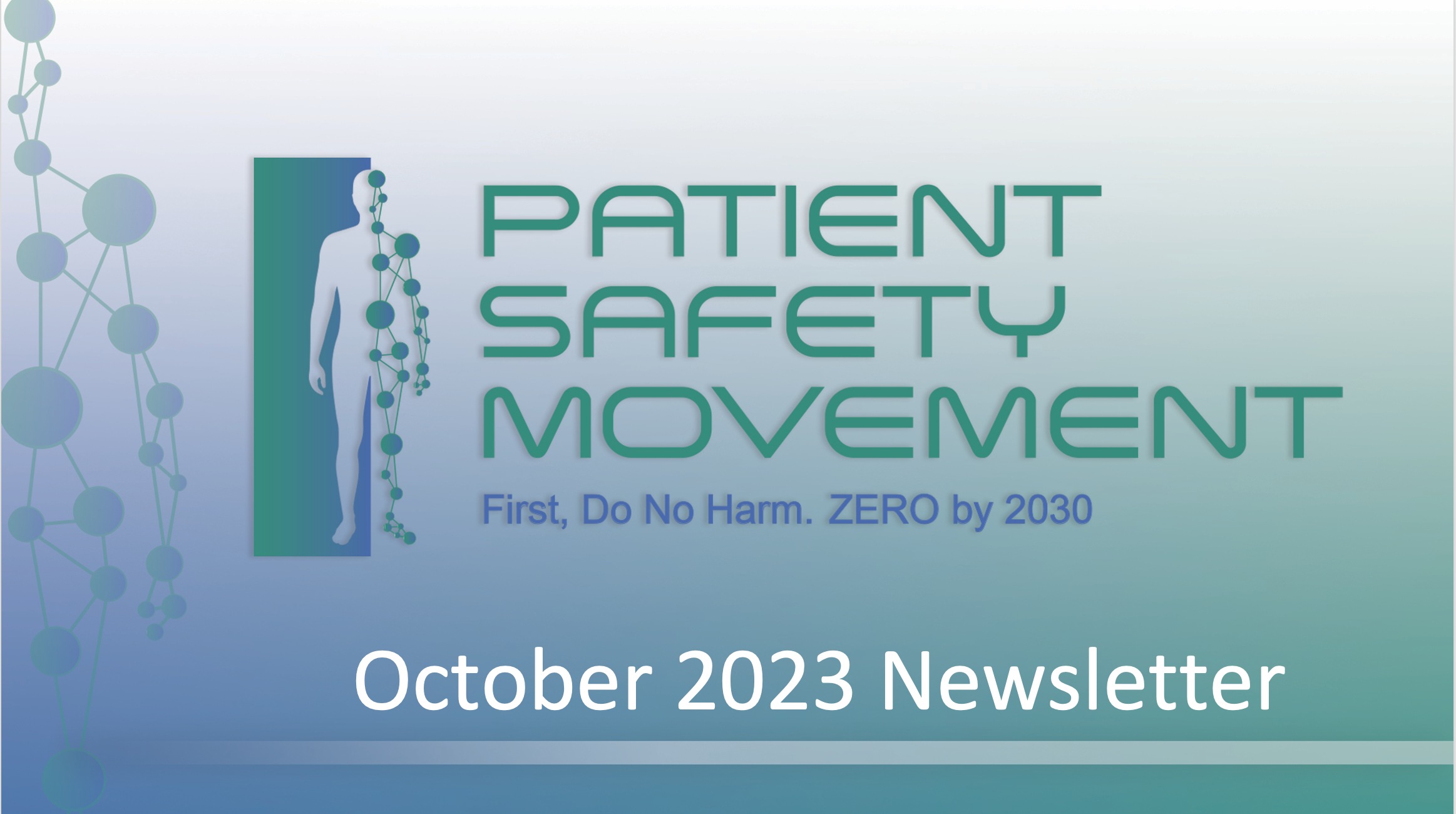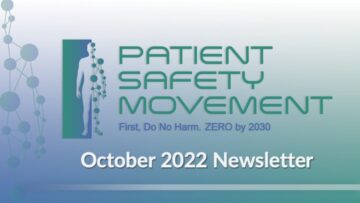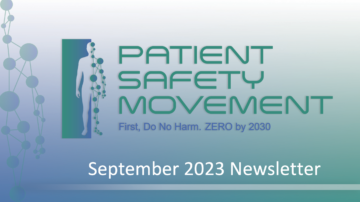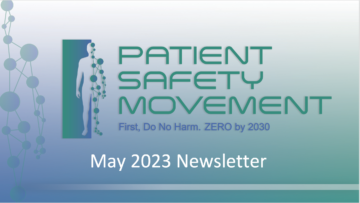Letter from CEO

The world is in more turmoil than usual, with wars going on and untold civilian casualties. We at the Patient Safety Movement Foundation are known for our recognition of loved ones who have lost someone from preventable harm in healthcare. Our website has many short videos that can bring a tear to your eye as you watch these tragic stories.
However, we also very strongly support the heroic efforts of our healthcare workers as we seek solutions to the system faults that lead to preventable errors occurring.
In this time of multiple wars, we also want to recognize the heroism of the healthcare workers who have stayed, or traveled to, very dangerous locations to take care of the injured—often at great risk to themselves and with very limited supplies. I would especially like to recognize those physicians and nurses who have made a point of coming to these battle areas from the safety of their homes. Organizations like Doctors Without Borders/Médecins Sans Frontières deserve a special “shout out” for their continued delivery of medical relief to people affected by conflict, epidemics, disasters, or exclusion from healthcare, without regard to race, religion, or political affiliation.
This international humanitarian organization was created in France by doctors and journalists in 1971. Now in over 70 countries around the world, they provide medical care where it is needed most: in armed conflicts, epidemics, natural disasters, and other crises. They are running close to 500 projects around the world and provide care based on needs alone and advocate for independent access to victims of conflict and disaster as required under international humanitarian law.
They received the Nobel Peace Prize in 1999. As an international nonprofit organization headquartered in Geneva, they commit all their resources to providing medical humanitarian care to those in need. Please give them your support, particularly at this time.
Their website is https://www.doctorswithoutborders.org.
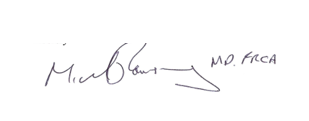
Michael A.E. Ramsay, MD, FRCA, Chief Executive Officer, PSMF
Breast Cancer Awareness Month
October is Breast Cancer Awareness Month, one of the most widely observed disease awareness months there is. In recognition of this important annual reminder, we spoke with Dr. Jennifer Baker, MD, FACS. Dr. Baker is a board-certified and fellowship-trained breast surgical oncologist and assistant professor of surgery at the University of California, Los Angeles.
According to Dr. Baker, breast cancer is still the most common cancer among women in the US, with 300,000 diagnoses expected in 2023. Statistics indicate that 1 in 8 women (13%) will be diagnosed in their lifetime. Not exclusive to women, 1% of breast cancer patients are men.
The mid-2000s unfortunately saw an uptrend in rates, some of which, according to Dr. Baker, may be related to excess body weight among postmenopausal women and later child births. The rate increase has been about 0.5% per year.
The biggest risk factors for breast cancer remain being born female and getting older, as 50% of diagnoses are in patients with no other risk factors. These other risk factors include:
- Family history (the more first-degree family members with breast cancer, the higher the risk)
- Known pathogenic genetic mutations (found in less than 10% of breast cancer patients)
- Breast biopsies that demonstrate atypical lesions
- Having dense breasts
- Certain hormone factors (e.g., lifetime exposure to estrogen)
Important modifiable risks are excess weight (especially in postmenopausal women) and insufficient exercise. Exercise is the most significant lifestyle factor that can decrease risk (as it is with many other cancers). Regular exercise, 30-40 minutes of exercise a day, is recommended. It also decreases the risk of reoccurrence. Lastly, alcohol consumption in excess of two to three drinks per week, or one per day, is another modifiable risk factor highlighted by Dr. Baker.
To learn more from Dr. Baker, be sure to watch this short video.
Breast Cancer Diagnostic Test
Breastlink Medical Group is a network of breast health centers located in California and Arizona. They believe the best way to prevent, detect, and treat breast cancer involves both collaborative care and full patient participation.
Mammography is the most common screening test for breast cancer. Breastlink recommends annual mammography screenings for all women over age 40. For women with an increased risk of breast cancer, magnetic resonance imaging (MRI) may be used as an additional screening tool.
Breastlink highlights the need for early detection for everyone at risk to improve patient safety outcomes: “We want to make sure ALL women have access to screening mammograms because finding cancer in its early stages is the key to survival.”
American Pharmacists Month
A statement from Dr. Jerika Lam and Dr. Reza Taheri from the School of Pharmacy, Chapman University.
In celebration of American Pharmacists Month in October, we would like to highlight the central role pharmacists play in safeguarding medication safety across the continuum of care, at both the individual patient care and systems levels.
At the patient care level, pharmacists ensure access to medications, provide medication information, evaluate their safety and appropriateness, furnish medications, manage complex treatment regimens, assess health status of patients, and coordinate care transitions. At the systems level, pharmacists lead medication safety programs, improve patient outcomes, reduce the cost of care, and implement patient safety and stewardship initiatives, such as antimicrobial, opioid, and pharmacogenomics programs.
Pending federal and state legislation has the potential to further expand pharmacists’ clinical services as healthcare providers. For example, H.R. 1770, introduced in the US House of Representatives, expands Medicare coverage to include services provided by a pharmacist related to testing, vaccines, and treatment for COVID-19, influenza, and certain other illnesses. This would ensure broad and equitable population access to care in preventing communicable diseases.
In California, two recently passed legislative bills expand the scope of practice of pharmacists. For example, AB 1341 addresses public health safety concerns by authorizing pharmacists to independently prescribe COVID-19 oral therapeutics until 2025 and administer injectable medications for opioid use disorder. Another bill, AB 317, requires commercial health plans to pay for any covered service performed by a pharmacist at a network pharmacy.
Taken together, the role of pharmacists as stewards of medication and patient safety continues to evolve and expand to benefit patients and our communities.
World Mental Health Day
World Mental Health Day on October 10 was established in 1992 by the World Federation for Mental Health to bring attention to mental health conditions and their major effects on people’s lives worldwide. This year, the World Health Organization (WHO) emphasized the theme “Mental health is a universal human right” to drive actions that promote and protect everyone’s mental health as a human right. According to WHO, this right includes “the right to be protected from mental health risks; the right to available, accessible, acceptable, and good quality care; and the right to liberty, independence, and inclusion in the community.”
Studies repeatedly show the importance of good mental health to our overall physical health, well-being, social and familial relationships, and even livelihoods. Unfortunately, 1 in 8 people globally live with a mental health condition, and an increasing number of young people are being affected as well.
According to the National Alliance of Mental Illness (NAMI), in the US:
• 1 in 5 adults experience mental illness each year.
• 1 in 20 adults experience serious mental illness each year.
• 1 in 6 youth aged 6–17 experience a mental health disorder each year.
• 50% of all lifetime mental illness begins by age 14, and 75% by age 24.
• Suicide is the second leading cause of death among people aged 10–14.
For additional information and resources to raise awareness and reduce the stigma around mental health, be sure to visit NAMI and WHO.
Infection Prevention Week
The focus of this year’s International Infection Prevention Week (October 15–21) is to get back to the fundamentals of infection prevention. According to the CDC, 1 in 31 hospitalized patients will get an infection as a result of their care, costing an estimated $28.4 to $45 billion each year. Of those getting a hospital-acquired infection (HAI) each year, an estimated 75,000 patients will die. Fortunately, patients and their families can protect themselves by learning and following these infection prevention basics:
- Speak up for your care.
- Clean your hands often.
- Ask about safe injection practices.
- Ask to have your room cleaned.
- Ask questions about your medication.
- Ask if you should shower before having surgery.
- Ask each day if you still need a catheter.
- Ask about vaccinations so you stay healthy.
It’s also important to be aware of the most common hospital-acquired infections:
- Catheter-associated urinary tract infection
- Surgical site infection
- Bloodstream infection
- Pneumonia
- Clostridium difficile
- Methicillin-resistant Staphylococcus aureus
- Vancomycin-resistant enterococcus
Healthcare workers can learn more and download checklists of actionable evidence-based practices to prevent HAIs on the Patient Safety Movement Foundation’s website.
Liver Awareness Month
The American Liver Foundation encourages everyone to find out if they are at risk for fatty liver disease during National Liver Awareness Month in October. Nonalcoholic fatty liver disease (NAFLD) is one of the most common causes of liver disease in the US and the most common cause of liver disease worldwide, affecting as many as one billion people. In children, NAFLD rates have doubled over the past 20 years.
NAFLD causes excess fat to build up in the liver and has few or no symptoms. The exact causes for NAFLD are unknown, but research suggests genetics, digestive disorders, and diet may be contributing factors. NAFLD is rapidly increasing as a common cause of liver cancer—a leading cause of cancer deaths in the US among all races, ethnicities, and genders, representing 30,000 adult deaths annually. Another form of NAFLD, nonalcoholic steatohepatitis (NASH), causes inflammation of the liver and liver damage, which can lead to liver failure.
Two of the most common risk factors for liver disease are diabetes and obesity. Through a simple liver health quiz, available at ThinkLiverThinkLife.org, anyone can learn about their own risk factors and what to do next.
Innovation Corner*
Nociception Monitoring—Completing the Triad of Objective Anesthesia Monitoring
Anesthesiologists are responsible for monitoring and treating three physiologic domains to provide a successful anesthetic: hypnosis, neuromuscular blockade, and analgesia. Processed EEG and quantitative TOF monitors allow for continuous measurement of the first two, yet a monitor to help guide analgesia to treat intraoperative “pain” (aka “nociception”) was not available until now.
Recently, the Food and Drug Administration approved the PMD-200 from Medasense Ltd. as the first nociception monitor in the US to be used as an adjunct device to assess changes in nociception levels in adult patients under general anesthesia receiving opioid or opioid-sparing analgesia(1).
The PMD-200 uses a finger probe, like a pulse oximeter probe, to measure heart rate, heart rate variability, photoplethysmograph amplitude, and skin conductance during the case.
Increased sympathetic output, because of insufficient analgesia during surgical and other stimuli, manifests as increased heart rate and skin conductance, and decreased heart rate variability and PPG amplitude.
The PMD-200 uses a machine learning algorithm to derive a nociception level index (NOL) from these parameters, with a nonlinear scale from zero (no nociception) to 100 (extreme nociception) (see image below). The machine learning algorithm personalizes its output to the specific patient by calibrating/normalizing the NOL at the beginning of the case during a period without stimulation.
The clinical guidance states the provider should titrate analgesics to maintain a NOL consistently below 25. The NOL index trend is most useful and should be used as an adjunct to other clinical signs and the provider’s experience in gauging the adequacy of analgesia.
In “standard” anesthesia practice, patients receive a loading dose of opioid followed by intermittent boluses at regular intervals, based on PK/PD, patient demographics, patient comorbidities, and provider experience. However, since inter-patient variability to opioids varies thirty-fold and patients respond differently to surgical stimuli, it’s not surprising that some patients experience severe postoperative pain. This occurs most commonly in opioid tolerant patients, the very elderly, and those with abnormal metabolism/elimination of opioids, since these patients are outliers in their response to a “standard” analgesic regimen.
Continuous nociception monitoring provides an objective, real-time measure of nociception, specific to the patient, allowing the right amount of analgesic to be administered at the right time, during most stimulating portions of the case.
This alignment of analgesic dosing to stimulation has shown to decrease PACU pain scores, reduce periods of hypotension, and reduce levels of stress hormones ACTH and cortisol in clinical studies(2). Most importantly, NOL monitoring reduced the number of patients with “severe” PACU pain (median pain score 7–10) by 70% compared to a control group.
The monitor is also helpful in confirming the adequacy of a regional or neuraxial block. A persistently high NOL index allows supplemental analgesia to be given through an indwelling catheter or directly into the surgical field, as is popular in thoracic cases.
There is a risk that the monitor can guide the provider to give too much analgesia, which in the case of opioids can result in respiratory depression. When used as an adjunct to clinical judgement, clinical trials have not found NOL-guided analgesia to result in a significant incidence of “overdose” or respiratory depression.
In summary, the NOL index provides an objective, continuous, personalized measure of nociception. Although the full range of benefits in a patient’s outcome remain to be determined, this monitor will likely contribute to making anesthesia safer and patient outcomes consistently better.
References:
(1) https://www.accessdata.fda.gov/scripts/cdrh/cfdocs/cfpmn/denovo.cfm?id=DEN210022
(2) https://medasense.com/peer-reviewed-publications/
Image: PMD-200 Monitor and finger probe

*Patient Safety Movement Foundation does not endorse any specific commercial products, services, or companies. Information included in this section is merely to share the technologies that may improve patient safety.
In the News
- Forbes wrote about the PCAST report on patient safety to Joe Biden, referencing the US president’s connection to Joe Kiani and the Patient Safety Movement Foundation.
- The Washington Post reported that serious harm inside Maryland’s 62 hospitals more than tripled between 2019 and 2022 to 769 incidents, reaching the highest level since the state began collecting patient safety data in 2004.
- Sage Growth Partners released a new patient safety report providing cross-sector insights from hospitals, health systems, nonprofit organizations, and technology companies, according to a press release posted on Yahoo! Finance.
- Nurses at a 256-bed hospital on Chicago’s south side voted unanimously to ratify a new three-year contract that contained protections to improve patient safety and nurse retention, as reported by National Nurses United.
- New York Institute of Technology, College of Osteopathic Medicine, celebrated the opening of the Ferrara Center for Patient Safety and Clinical Simulation in Long Island, featuring updated virtual patient examination rooms and simulation labs.
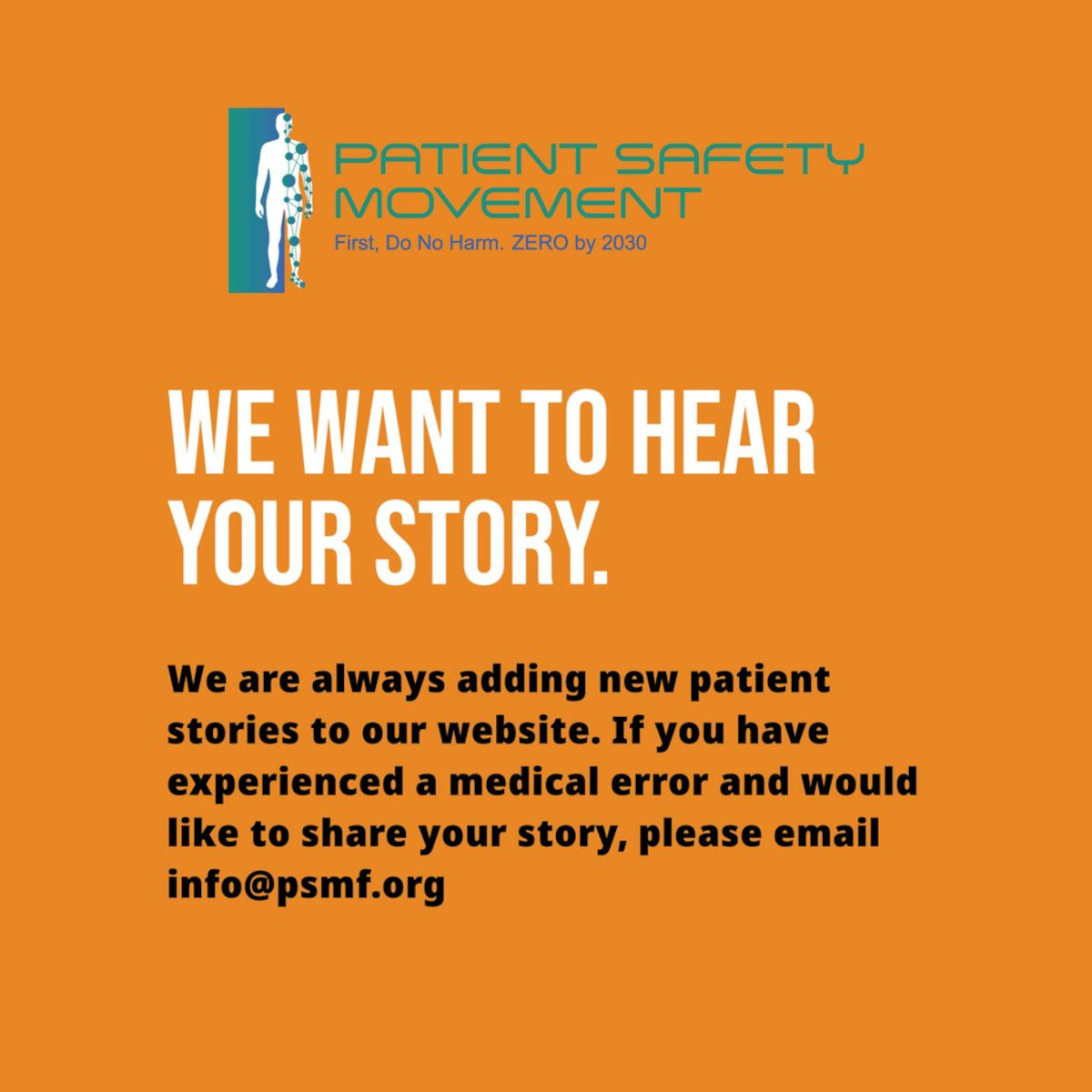
DONOR TESTIMONIALS — WHY I GIVE
The following has been slightly edited for brevity and clarity:
Patient safety is critically important to me. When I began working in healthcare and managing laboratories, I learned how some of our processes are not as reliable as we need them to be and how easy it is to make mistakes. I made mistakes. Making a mistake that got all the way through to a patient brought patient safety to life for me early in my career.
The Patient Safety Movement Foundation brings transparency to healthcare, not just the numbers but the human impact—through their focus on stories, the things that have gone wrong. Their annual Summit brings people together, where we work together, learn from each other, and distill best practices. I really love the community of people coming together, being transparent, being honest, getting to the truth about what went wrong and why it went wrong, so that everybody who is part of the community can learn and get better.
Every single person is a consumer of healthcare at some point in time. I encourage others to learn more about the Patient Safety Movement Foundation and contribute to it. If you can play a part in making their efforts accessible to every single person who does the work, closing the gaps will go a lot faster.
Shana Padgett
VP of Advisory Services
Value Capture LLC
GOVERNANCE BOARD
Joe Kiani, MS, Founder and Immediate Past Chairman of PSMF, Founder, Chairman & CEO of Masimo
Mike Durkin, OBE, MBBS, FRCA, FRCP, DSC, Chairman of PSMF, Senior advisor on Patient Safety Policy and Leadership, Institute of Global Health Innovation, Imperial College London
Michael A.E. Ramsay, MD, FRCA, Chief Executive Officer, PSMF
Sarah Kiani, Director, Masimo Foundation for Ethics, Innovation, and Competition
Abbasseh Towfigh, MPD, Executive Director and Secretary, Ayeneh Foundation
Steven J. Barker, PhD, MD, Chief Science Officer, Masimo Corporation, Professor Emeritus of Anesthesiology, University of Arizona Health Sciences
Jannicke Mellin-Olsen, MD, DPH, Past President, World Federation of Societies of Anesthesiologists
Philip D. Lumb, MB, BS, MD, MCCM, FCCP, Professor of Anesthesiology, Keck School of Medicine, University of Southern California
Najmedin Meshkati, PhD, MS, Professor of Civil/Environmental Engineering, University of Southern California
Javier T. Davila, MD, Ambassador, PSMF in Mexico, Former Medical Director, Mexican Social Security Institute, Head of Medical Education, Research and Health Public Policy
Robin Betts, RN, CPHQ, MBA-HA, Vice Chair, PSMF, Vice President, Safety Quality & Regulatory Services, Kaiser Foundation Hospitals and Health Plan, Kaiser Permanente Northern California
Nasim Afsar, MD, MBA, MHM, Chief Health Officer at Oracle Health
Edward Kelley, PhD, Chief Global Health Officer, ApiJect Systems
David B. Mayer, MD, Executive Director, MedStar Institute for Quality and Safety
Omar Ishrak, PhD, Executive Chairman and Chairman of the Board of Directors, Medtronic, Chairman of the Board of Directors, Intel
Charlie Miceli, CPM, Treasurer, PSMF, Chief Supply Chain Officer, Network VP of University of Vermont Health Network
Vonda Vaden Bates, Patient Advocate, CEO, 10th Dot
Alicia Cole, Patient Safety Consultant
Jim Messina, BA, CEO, The Messina Group
OUR STORY
 In 2012, Joe Kiani founded the nonprofit Patient Safety Movement Foundation (PSMF) to eliminate preventable medical errors in hospitals. His team worked with patient safety experts from around the world to create Actionable Evidence-Based Practices (AEBP) that address the top challenges. The AEBP is available without charge to hospitals online.
In 2012, Joe Kiani founded the nonprofit Patient Safety Movement Foundation (PSMF) to eliminate preventable medical errors in hospitals. His team worked with patient safety experts from around the world to create Actionable Evidence-Based Practices (AEBP) that address the top challenges. The AEBP is available without charge to hospitals online.
Hospitals are encouraged to make a formal commitment to ZERO preventable deaths, and healthcare technology companies are asked to sign the Open Data Pledge to share their data so that predictive algorithms that can identify errors before they become fatal can be developed. The Foundation’s annual World Patient Safety, Science & Technology Summit brings together all stakeholders, including patients, healthcare providers, medical technology companies, government employers, and private payers. The PSMF was established through the support of the Masimo Foundation for Ethics, Innovation, and Competition in Healthcare. For more information, please visit psmf.org.

